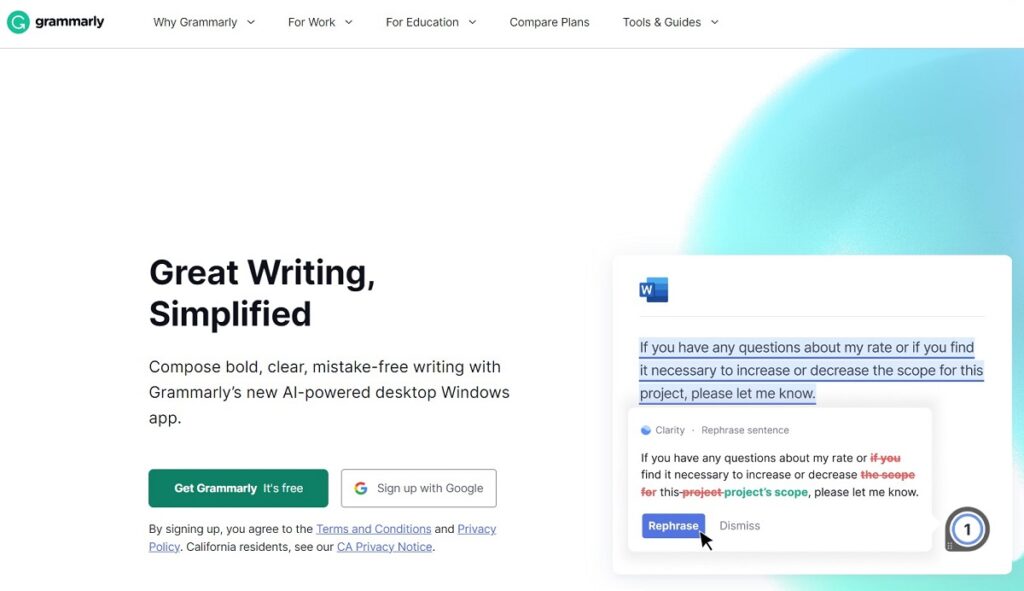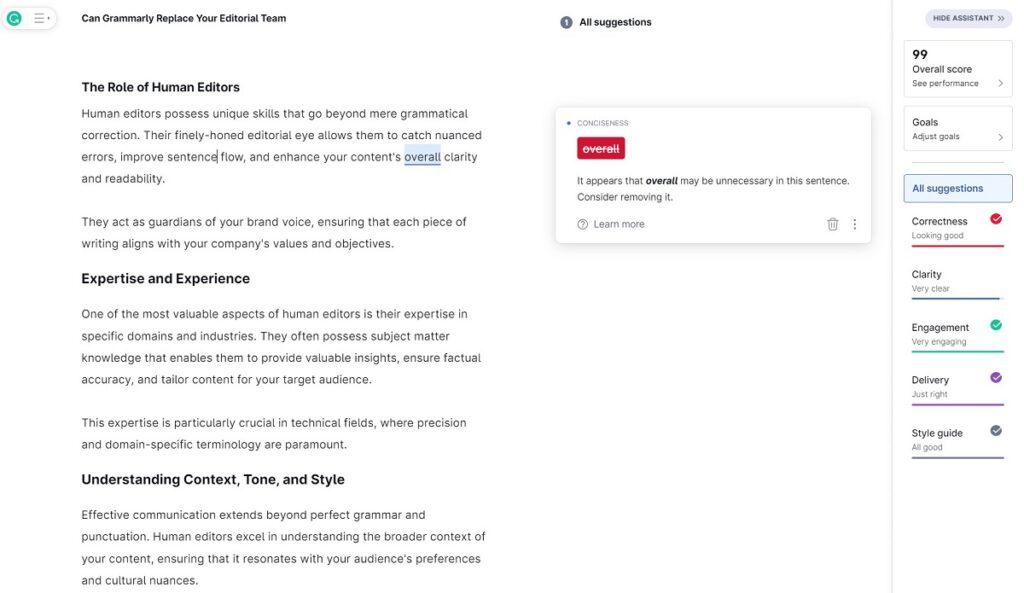*This article was last updated on 23/07/2023
Efficient communication and compelling content are critical drivers for success. As a business owner, you understand the importance of maintaining high-quality written materials that resonate with your audience and uphold your brand image.
However, achieving such standards often requires a dedicated editorial team, which can be a significant financial investment.
Enter Grammarly – an AI-powered writing assistant that promises to streamline your editing process. Wouldn’t you save lots of money by downscaling your editorial team if that were the case? Today we’ll look at Grammarly and see if that’s possible.
What is Grammarly?

Grammarly is an AI-based tool that offers a comprehensive suite of writing and editing features. Its sophisticated algorithms enable it to detect and accurately correct grammar, punctuation, and spelling errors.
Moreover, Grammarly provides style and tone suggestions to ensure your writing aligns perfectly with your brand’s voice and audience’s preferences.
How Grammarly Can Potentially Help You Cut Costs
With the rising popularity of Grammarly, many business owners have started to wonder if this AI-powered tool can replace or reduce their reliance on traditional editorial teams. Let’s explore some of the potential cost-cutting benefits that Grammarly brings to the table:
Streamlined Editing Process
Grammarly’s automated and real-time editing capabilities significantly speed up content refinement. It allows your team to identify and correct errors on the fly, eliminating the need for time-consuming back-and-forths between writers and editors.
Consistency Across Content
Maintaining consistency in tone, style, and brand messaging is crucial for establishing a solid brand identity. Grammarly’s consistent editing suggestions help ensure that all your content adheres to your brand guidelines, enhancing your brand’s overall cohesiveness.
Reduced Reliance on External Editors
You should be able to engage external editors less frequently by leveraging Grammarly’s features. This reduction in outsourcing can lead to substantial cost savings without compromising the quality of your content.
Accessibility for All Team Members
Grammarly’s user-friendly interface and accessibility make it an invaluable tool for all members of your team, regardless of their writing expertise. It empowers your employees to produce better-quality content independently, reducing the need for specialized editorial oversight.
Now, all of this sounds great. The problem is, does Grammarly deliver on what it promises? More importantly, is it reliable enough to replace the skills and expertise of a professional editor? Let’s first compare what Grammarly aims to deliver against the skills of a human editor.
The Role of Human Editors
Human editors possess unique skills that go beyond mere grammatical correction. Their finely-honed editorial eye allows them to catch nuanced errors, improve sentence flow, and enhance your content’s clarity and readability.
They act as guardians of your brand voice, ensuring that each piece of writing aligns with your company’s values and objectives.
Expertise and Experience
One of the most valuable aspects of human editors is their expertise in specific domains and industries. They often possess subject matter knowledge that enables them to provide valuable insights, ensure factual accuracy, and tailor content for your target audience.
This expertise is particularly crucial in technical fields, where precision and domain-specific terminology are paramount.
Understanding Context, Tone, and Style
Effective communication extends beyond perfect grammar and punctuation. Human editors excel in understanding the broader context of your content, ensuring that it resonates with your audience’s preferences and cultural nuances.
They can adapt the tone and style of writing to suit different platforms and tailor content for various stages of the buyer’s journey.
Addressing Subjectivity and Bias
Human editors are well-versed in balancing preserving your unique brand voice and adhering to industry standards. They are attuned to your company’s vision and values, ensuring your content remains authentic and relatable.
Moreover, they can identify potential biases in your writing and help ensure your content is inclusive and unbiased.
Grammarly vs Editors: The Pros and Cons

Based on what we’ve covered, we can see that Grammarly and human editors have different skill sets. Because of this, it’s not necessarily the case that Grammarly should be considered a replacement for writers and editors.
Rather than viewing human editors and Grammarly as competing solutions, consider them partners in your content creation process. By embracing a collaborative approach, you can leverage both strengths to achieve the best possible outcome for your content.
| Human Editors | Grammarly | |
| Pros | Personal touch and creativity | Speed and efficiency |
| Understanding intent and context | Consistency across content | |
| Critical eye for subtleties | Technical accuracy | |
| Knowledge of Industry-specific Terminology | Accessibility and cost-effectiveness | |
| Cons | Cost and time-consuming | Contextual limitations |
| Subjectivity and bias | Handling complex sentence structures | |
| Limited scalability | Industry-specific jargon |
It’s essential to recognize the indispensable role that human editors play in the content creation process. While Grammarly offers significant benefits, human editors bring a level of expertise, context, and creativity that automated tools can only partially replace.
Recommendation: Work Toward This Ideal Editorial Workflow
The key to maximizing the benefits of both human editors and Grammarly lies in creating an ideal editing workflow that harnesses the strengths of both approaches. By integrating Grammarly as a complementary tool within your existing editorial team, you can effectively achieve synergy and streamline your content creation process.
1. Use Grammarly as a First-Pass Automated Tool
To capitalize on Grammarly’s speed, efficiency, and technical accuracy strengths, consider implementing it as a first-pass automated tool for your content. As your team drafts new materials, have them run the content through Grammarly for initial checks.
Grammarly’s real-time editing capabilities will swiftly catch grammar, punctuation, and spelling errors, ensuring that your content meets the basic standards of well-written material. It will also assist in maintaining consistency in tone and style across your various pieces, reinforcing your brand identity and creating a cohesive brand voice.
2. Let Human Editors Add Refinement and Creativity
While Grammarly handles the technicalities, human editors play a crucial role in refining your content to meet higher standards of excellence. Engage human editors for more in-depth editing tasks, particularly for critical pieces, marketing campaigns, or technical content.
Human editors can provide the personal touch that resonates with your audience, ensuring that your content aligns seamlessly with your brand’s personality and objectives. Their expertise in industry-specific terminology will maintain the accuracy and clarity necessary for specialized fields.
3. Balance Cost-effectiveness and Quality
You can achieve optimal cost-effectiveness without compromising content quality by striking a careful balance between using Grammarly and human editors. Leverage Grammarly for routine content; its speed and efficiency can significantly reduce editing costs.
For content that demands a deeper level of refinement, such as thought leadership articles or marketing materials, enlist the expertise of human editors. They can add valuable insights, context, and creativity, elevating your content to captivate your audience and deliver your message effectively.
4. Collaboration Brings Continuous Improvement
An essential aspect of an ideal editing workflow is fostering collaboration between your team members, Grammarly, and human editors. Encourage open communication and feedback loops, allowing your writers and editors to work seamlessly with Grammarly’s suggestions and incorporate human insights for further improvement.
Real-World Examples of Collaborative Success
To provide concrete examples of this synergistic approach, we will explore real-world case studies of businesses that have successfully integrated both Grammarly and human editing into their content creation processes.
These examples will demonstrate how this collaborative model has led to cost savings, improved content quality, and enhanced overall efficiency for these businesses.
Case Study 1: The Non-native English Speaker
Let’s start with Jane, an SEO specialist for a burgeoning tech startup. She was tasked with creating and editing blog posts to boost the company’s online visibility. However, Jane was not a native English speaker and often struggled with grammar and punctuation. Enter Grammarly.
With Grammarly’s advanced grammar, punctuation, and spelling checks, Jane could polish her content to a high standard. The tool’s suggestions for vocabulary enhancement also helped her diversify her language use, adding that much-needed touch of perplexity.
Moreover, Grammarly’s readability score guided her in creating a good mix of simple and complex sentences, increasing the burstiness of her writing. The result? A series of SEO-optimized blog posts that not only ranked well but also resonated with readers.
Case Study 2: Building Consistency for Marketing Teams
Next, we have the content marketing team at a renowned e-commerce company. They were working on a comprehensive guide for their customers, but they faced a challenge: ensuring consistency in tone and style across multiple sections written by different team members.
Grammarly came to their rescue. With its style guide feature, the team could set specific guidelines for their writing. Despite having multiple authors, this helped maintain a consistent voice throughout the guide.
The tool’s context-specific suggestions also ensured the content was relevant and coherent. The team’s guide was a hit, enhancing customer engagement and boosting their SEO rankings.
Case Study 3: Boosting The Performance of Experienced Professionals
Finally, let’s talk about Tom, a freelance editor who often juggles multiple projects simultaneously. His biggest challenge was managing his time effectively while ensuring top-notch quality for all his clients’ content.
Grammarly proved to be a game-changer for Tom. Its real-time grammar and spelling checks saved him countless hours of proofreading. The tool’s suggestions for sentence variety helped him enhance his clients’ content.
With Grammarly, Tom delivered high-quality, contextually relevant content on time, every time, leading to happy clients and a thriving freelance business.
Leveraging Grammarly and Human Editors in Harmony
In today’s dynamic business landscape, the demand for high-quality content that resonates with audiences has never been greater. Whether Grammarly can replace human editors as a cost-cutting measure has been explored.
As a prudent approach, we advocate for a balanced and collaborative workflow that leverages both Grammarly and human editors. You can reduce editing costs by integrating Grammarly as a first-pass automated tool for routine content.
However, human editors must provide the necessary finesse, creativity, and domain expertise for critical pieces and specialized content. Cherish the invaluable human touch of your experienced editors.
